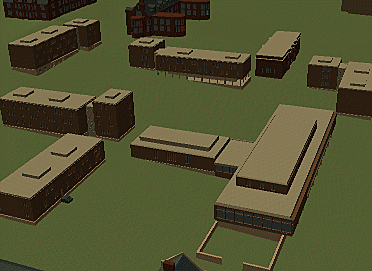4. Dormitories of the 1960s
New Quad Vintage CAD
Even for a campus of many names, the buildings that now comprise Wilson and Butler Colleges have changed identity often since they were built in the early and mid-1960s.

Princeton University. Property of the Trustees of Princeton University.
1915 Hall

Princeton University. Property of the Trustees of Princeton University.
Source: Princeton University Archives, Mudd Library, Grounds & Buildings, MP 29
For example, the buildings were arranged to form an asymmetrical quadrangle, as found with the Collegiate Gothic dormitories, and the brick and limestone trim were consistent in material if not color with the existing 1915 Hall, ...
McCosh Infirmary

Princeton University. Property of the Trustees of Princeton University.
Source: Princeton University Archives, Mudd Library, Grounds & Buildings, MP 51
...McCosh Infirmary, ...
Eno Hall

Princeton University. Property of the Trustees of Princeton University.
Source: Princeton University Archives, Mudd Library, Grounds & Buildings, SP 3
...Eno Hal, ...
Guyot Hall

Princeton University. Property of the Trustees of Princeton University.
Source: Robert J. Clark
...and Guyot.
New New Quad Vintage CAD

Princeton University. Property of the Trustees of Princeton University.
Even as the dormitories of New Quad were opening their doors to their first undergraduates, plans were well underway to build a second entire matched complex of dormitories immediately to the south. These buildings -- Lourie-Love, 1922, 1940, 1941, and 1942 Halls -- inevitably became known as "New New Quad," a name they retained until the construction of Wu Hall in 1983 and the creation of Butler College.
The Butler College dorms added almost 100,000 square feet of dormitory space, enough for some 325 students, and cost $2.3 million. They were designed by Hugh Stubbins, who wrote at the time that his design was not a sharp break with the traditional Gothic of the upper campus. Rather, he sought "to capture the traditional scale in a modern idiom."
Stubbins achieved this effect by varying the number of stones in each unit, staggering the wall planes of the New New Quad buildings, and punctuating the walls with thin vertical lines. "This is in keeping with the buttresses and crenellations of the old Gothic buildings," he explained. Stubbins also sited the five buildings to create two modest but connected courtyards, in contrast to the large single quadrangle of New Quad.
Not all alumni were impressed. As one wrote to the Princeton Alumni Weekly, "Why a low-income urban renewal project in the middle of those beautiful fields?" (New New Quad had continued the southward march of the campus onto the playing fields, encroaching onto what had been Goldie Field.)
Construction of the Stubbins buildings started in 1963, and most of them were ready for occupancy by the autumn of 1964. Although the addition of these dormitory spaces relieved overcrowding, it proved only a temporary expedient. The advent of coeducation in 1969 and increased demand for married undergraduate housing forced Princeton to construct one final complex of dorms, the eight units of Spelman Hall.
Spelman Hall

Princeton University. Property of the Trustees of Princeton University.
Source: Christine Kitto-Princeton University
One has to wonder what Moses Taylor Pyne, a prime mover of Collegiate Gothic at Princeton, would have thought of Pei's futuristic designs adjacent to the dormitory bearing his name.
Pei wrote that his objectives in designing Spelman were to preserve the topography of the site and "to further the informal sequence of open spaces, building enclosures, and vista traditional to Princeton." He noted that the complex was also intended to bring New South into "a positive relationship" with the campus and to link the recently acquired Princeton Inn more closely to the main campus.
Most of the units in Spelman were suites comprising of four bedrooms, a bathroom, a living room, and fully equipped kitchenette. The eight Spelman entryways -- each in fact a separate building -- were four stories tall and contained a total of 58 apartments, enough for 220 people. The total cost of $3.5 million was the most Princeton has yet spent on a dormitory.
The University and Pei originally had other plans for the area between Princeton Inn and the main campus. In 1969-70, at Princeton's request, Pei devised an ambitious master plan for residential and commercial development along University Place between the Dinky Station and McCarter Theater. The goal of this endeavor was to further connect Princeton Inn, recently acquired by the University for new dormitory space called Forbes College, with the rest of the campus -- a tricky enterprise, given the "dead space" around the train station.
The University and townspeople, however, balked at the scale of Pei's proposals, and they were rejected. Yet the idea of revitalizing this segment of the campus remains on the wish-list for planners in both town and gown. The enormous success of the one going enterprise in this area, the 24-hour Wawa Market, illustrates the commercial potential of this location. Ironically, the Wawa also fulfills the role that Pei envisaged, serving as a major linkage between the disjunct Forbes College complex and the main campus.


In the beginning, there was New Quad: the group of dormitories encompassing Gauss, Dodge-Osborn,1937, 1938, and 1939, all centered around the dining and social facilities of Wilcox Hall.
At first it was called Wilson Lodge, and this complex was an immediate hit with undergraduates, many of whom had been clamoring for alternatives to the eating clubs. In 1967, Wilson Lodge was rechristened Wilson College, in which form it continues today.
The six original New Quad buildings were designed by the firm of Sherwood, Mills and Smith, with Lester Smith '30 taking the lead. Built of the same materials -- pale Shenco brick with limestone trim -- these structures were erected simultaneously, with ground being broken in August 1959. Most of the buildings were ready for occupancy by September 1960.
Reflecting the other pressing demands on the University's resources, Smith's designs emphasized functionality rather than style, although he did make several overt gestures to the "old" campus.